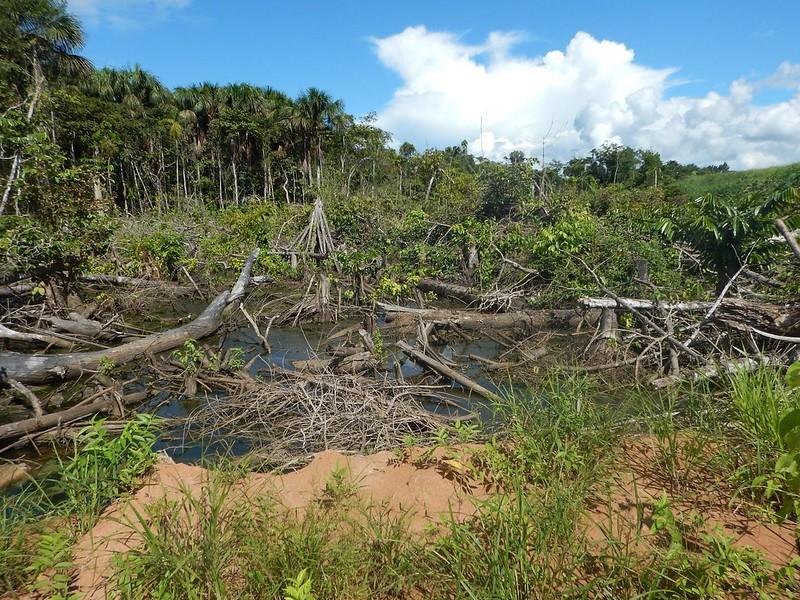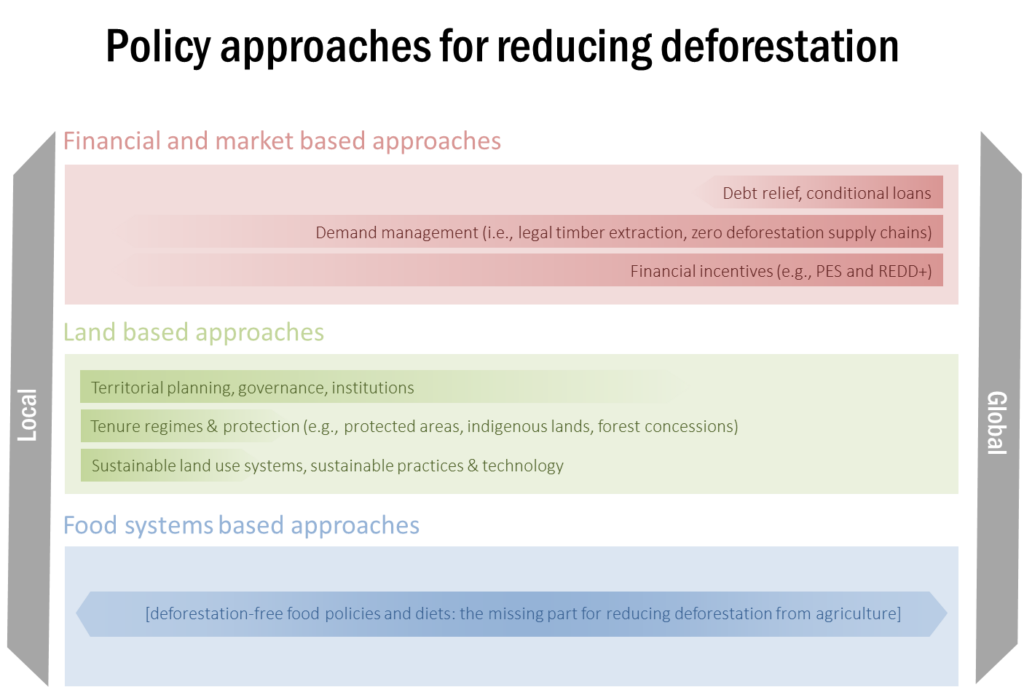Blog COVID-19 highlights the need for food systems-based policies for reducing tropical deforestation

Deforestation has many drivers but one is often overlooked: food consumption in cities that increases demand for products produced on deforested land. To be successful, tropical countries’ zero-deforestation policies need to address changing urban food demands.
Photo credit: Terra-i
Reducing rates of deforestation in the tropics is a complex puzzle, and we appear to be missing a few of its pieces, considering deforestation continues to progress at an unsustainable rate. Strategies to reduce deforestation have long recognized the importance of industrial agriculture oriented toward consumption at the global scale. As a result, globally consumed export commodities are flagged as key drivers of deforestation, leading to the proliferation of global initiatives, voluntary zero-deforestation agreements, and certifications and incentives at the international level. While important, agricultural exports globally account for slightly less than 20% of total production, with domestic consumption making up the balance, which leads us to believe that one piece of the puzzle is likely linked with small and medium agriculture production and shifting domestic consumption patterns.
Across Latin America, diets have changed significantly over the past decades as economies and incomes increased and consumers sought convenient foods better suited to their modern lifestyles (Quintero-Lesmes & Herran, 2019). Countries such as Colombia, Ecuador and Peru follow these same trends with increasing shifts towards processed foods, which is reflected in changing production systems – often those located at the agricultural frontier.
Unlike the case of export food chains with high-visibility zero-deforestation commitments from branded companies, there are few instruments available to reduce deforestation attributed to small and medium producers focused on the domestic market. Largely this is the result of public policies that have overlooked and ultimately abandoned these producers. In Peru, for example, a recent study (under review) reported low correlations between deforestation and the production of export agricultural commodities, such as cacao and coffee (Castro-Nunez et al., 2020). Increased production on forest margins of palm oil and short-cycle fruits and crops, such as maize for the poultry industry, for example, is driven by demand in urban centers. In turn, these demands reflect changes in diets in terms of processed food, fruit and poultry consumption, all of which have increased substantially in Peru over the last decade due to rising incomes.
As economies in developing countries grow, increased economic opportunities in cities lead to urban migration and population growth, subsequently increasing urban demand for agricultural products, which has been linked with increasing tropical deforestation, particularly in Asia and Latin America. For example, DeFries et al. (2010) identified urban markets in developing countries and export markets in both developing and developed ones as demand sources for deforestation. Despite this linkage, most work has focused nearly exclusively on global export markets as deforestation drivers ignoring or underplaying the importance of domestic diet shifts and consumption patterns.
The assumption that subsistence low-opportunity cost agriculture is one of the major drivers of tropical deforestation is becoming less valid over time. Research suggests that small-scale subsistence farmers with little connection to markets deforest less, highlighting the importance of commercial market demand as an underlying cause of deforestation (DeFries et al., 2010). Some of these linkages are direct (e.g., expansion of ranching activities for dairy or beef production), while others are indirect (e.g., growing maize production for poultry feed or palm oil for snack foods). Nonetheless, both respond to increasing incomes in urban areas that in turn support higher calorie consumption, increased reliance on processed and prepared foods and the adoption of less diverse dietary patterns by all social strata.
Despite the reported parallel changes in diets and production systems, little has been done to understand the relationship between shifting consumption patterns and land-use change and even less has been done to develop policies to incentivize sustainable land use through shifts in consumer behavior in tropical countries. Thus, a key component to reducing deforestation may lie at understanding the nexus of land and food systems. There is a need to better understand the relationship between production and dietary shifts and to incorporate this knowledge into developing and promoting deforestation-free food policies and diets that could simultaneously contribute to climate change mitigation, biodiversity conservation and green economic recovery post-pandemic.
Furthermore, given the current COVID-19 crisis, the short-term development priorities of both developing and developed countries will be largely related to food production, job creation, and economic reconstruction. In the wake of the crisis, many city residents are returning to their home districts to subsist through farming, and we will likely see a migration of workers to agricultural frontiers in search of income opportunities.

The situation generated by COVID-19 provides an opportunity to define the type of food systems that we would like to see in the future and that can contribute to reducing deforestation. According to Hepburn et al. (2020), and considering the rescue packages in relation to COVID-19 in G20 countries, only 4% of policies are ‘green’, while 92% are ‘colorless’, meaning that they maintain the status quo, and 4% are ‘brown’ and likely to increase net GHG emissions. A sustainable food systems lens has the potential to inform the discussion in relation to how investments should be prioritized for a more sustainable world.
Existing land-based policy approaches, and incentives and market-based approaches, need to be complemented with policies targeting both domestic agriculture and globally traded commodities. To do so, researchers and policymakers must use a sustainable food systems lens to develop and promote policy approaches that support sustainable low-deforestation food production systems via incentivizing sustainable, inclusive, and healthy consumption patterns

Figure 1. Policy approaches for reducing deforestation.
Figure 1 represents the different financial and market-based approaches that have been implemented alongside land-based approaches to address tropical deforestation associated with both subsistence and globally traded commercial agriculture. Missing from these are approaches based on the understanding that developing countries’ consumption patterns and diets deal with deforestation associated with small and medium farmers linked with domestic markets. Such initiatives must be employed concertedly while engaging national, international, and public and private sector actors to effectively address deforestation in tropical countries.
Read more about the Alliance’s response to COVID-19 impacts on global food systems
Ideas presented in this blog were developed by Augusto Castro from the Alliance of Bioversity International and CIAT based on discussions on the need for novel approaches for reducing deforestation and forest degradation with Mark Lundy, from the Alliance of Bioversity International and CIAT, and Charlotte Flechet and Johanna Renckens from Rikolto.
This Blog was supported by the project “Implementing Sustainable Agricultural and Livestock Systems for Simultaneous Targeting of Forest Conservation for Climate Change Mitigation (REDD+) and Peacebuilding in Colombia” aims to contribute toward reducing land-based greenhouse gas (GHG) emissions, conserving forest, restoring degraded landscapes, and improving rural livelihoods while stimulating peacebuilding in rural Colombia. It is part of the International Climate Initiative (IKI). The Federal Ministry for the Environment, Nature Conservation and Nuclear Safety (BMU) supports this initiative on the basis of a decision adopted by the German Bundestag. The SLUS project is implemented by CIAT, together with the Centre for Research on Sustainable Agriculture (CIPAV), Leibniz Centre for Agricultural Landscape Research, and Thünen-Institut.
Castro-Nunez, A.; Bax, V.; Ganzenmuller, R.; Francesconi, W. (under review). Emerging scenarios on the role of supply chain initiatives in reducing deforestation: evidence from Peru. Manuscript submitted for publication.
DeFries, R.; Rudel, T.; Uriarte, M. et al. (2010). Deforestation driven by urban population growth and agricultural trade in the twenty-first century. Nature Geosci 3, 178–181. https://doi.org/10.1038/ngeo756
Hepburn C.; O’Callaghan B.; Stern N.; Stiglitz J.; Zenghelis D. (2020). Will COVID-19 fiscal recovery packages accelerate or retard progress on climate change? Forthcoming in the Oxford Review of Economic Policy 36(S1).
Quintero-Lesmes, D.C.; Herran, O.F. (2019). Food changes and geography: Dietary transition in Colombia. Annals of Global Health, 85(1).
